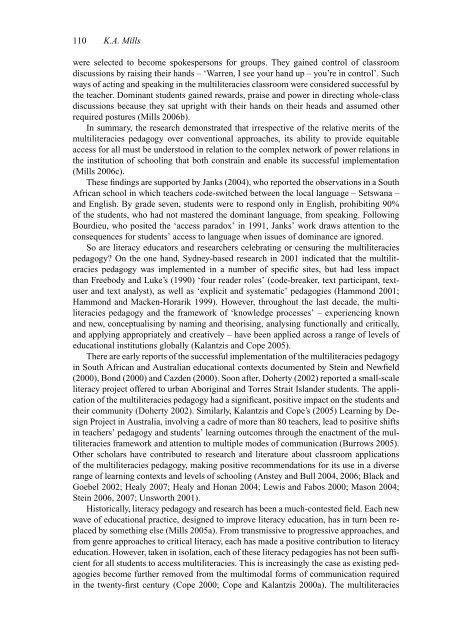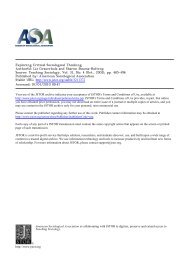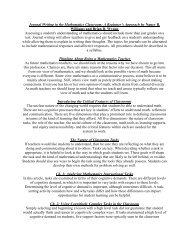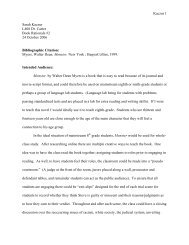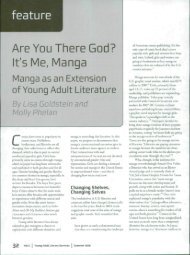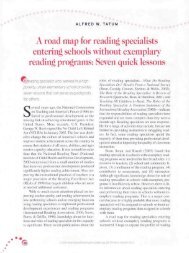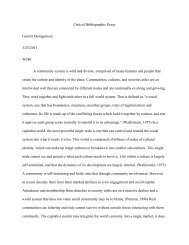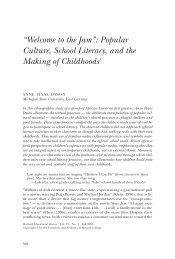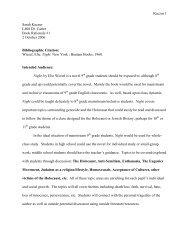Mills (2009) Interogating competing multiliteracy ... - Oncourse
Mills (2009) Interogating competing multiliteracy ... - Oncourse
Mills (2009) Interogating competing multiliteracy ... - Oncourse
You also want an ePaper? Increase the reach of your titles
YUMPU automatically turns print PDFs into web optimized ePapers that Google loves.
110 K.A. <strong>Mills</strong><br />
were selected to become spokespersons for groups. They gained control of classroom<br />
discussions by raising their hands – ‘Warren, I see your hand up – you’re in control’. Such<br />
ways of acting and speaking in the multiliteracies classroom were considered successful by<br />
the teacher. Dominant students gained rewards, praise and power in directing whole-class<br />
discussions because they sat upright with their hands on their heads and assumed other<br />
required postures (<strong>Mills</strong> 2006b).<br />
In summary, the research demonstrated that irrespective of the relative merits of the<br />
multiliteracies pedagogy over conventional approaches, its ability to provide equitable<br />
access for all must be understood in relation to the complex network of power relations in<br />
the institution of schooling that both constrain and enable its successful implementation<br />
(<strong>Mills</strong> 2006c).<br />
These findings are supported by Janks (2004), who reported the observations in a South<br />
African school in which teachers code-switched between the local language – Setswana –<br />
and English. By grade seven, students were to respond only in English, prohibiting 90%<br />
of the students, who had not mastered the dominant language, from speaking. Following<br />
Bourdieu, who posited the ‘access paradox’ in 1991, Janks’ work draws attention to the<br />
consequences for students’ access to language when issues of dominance are ignored.<br />
So are literacy educators and researchers celebrating or censuring the multiliteracies<br />
pedagogy On the one hand, Sydney-based research in 2001 indicated that the multiliteracies<br />
pedagogy was implemented in a number of specific sites, but had less impact<br />
than Freebody and Luke’s (1990) ‘four reader roles’ (code-breaker, text participant, textuser<br />
and text analyst), as well as ‘explicit and systematic’ pedagogies (Hammond 2001;<br />
Hammond and Macken-Horarik 1999). However, throughout the last decade, the multiliteracies<br />
pedagogy and the framework of ‘knowledge processes’ – experiencing known<br />
and new, conceptualising by naming and theorising, analysing functionally and critically,<br />
and applying appropriately and creatively – have been applied across a range of levels of<br />
educational institutions globally (Kalantzis and Cope 2005).<br />
There are early reports of the successful implementation of the multiliteracies pedagogy<br />
in South African and Australian educational contexts documented by Stein and Newfield<br />
(2000), Bond (2000) and Cazden (2000). Soon after, Doherty (2002) reported a small-scale<br />
literacy project offered to urban Aboriginal and Torres Strait Islander students. The application<br />
of the multiliteracies pedagogy had a significant, positive impact on the students and<br />
their community (Doherty 2002). Similarly, Kalantzis and Cope’s (2005) Learning by Design<br />
Project in Australia, involving a cadre of more than 80 teachers, lead to positive shifts<br />
in teachers’ pedagogy and students’ learning outcomes through the enactment of the multiliteracies<br />
framework and attention to multiple modes of communication (Burrows 2005).<br />
Other scholars have contributed to research and literature about classroom applications<br />
of the multiliteracies pedagogy, making positive recommendations for its use in a diverse<br />
range of learning contexts and levels of schooling (Anstey and Bull 2004, 2006; Black and<br />
Goebel 2002; Healy 2007; Healy and Honan 2004; Lewis and Fabos 2000; Mason 2004;<br />
Stein 2006, 2007; Unsworth 2001).<br />
Historically, literacy pedagogy and research has been a much-contested field. Each new<br />
wave of educational practice, designed to improve literacy education, has in turn been replaced<br />
by something else (<strong>Mills</strong> 2005a). From transmissive to progressive approaches, and<br />
from genre approaches to critical literacy, each has made a positive contribution to literacy<br />
education. However, taken in isolation, each of these literacy pedagogies has not been sufficient<br />
for all students to access multiliteracies. This is increasingly the case as existing pedagogies<br />
become further removed from the multimodal forms of communication required<br />
in the twenty-first century (Cope 2000; Cope and Kalantzis 2000a). The multiliteracies


